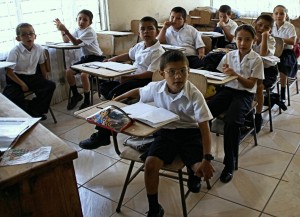Education… it elicits warm images of smiling children, colorful classrooms and fundamental ideas like opportunity and a brighter future. I am happy to say I see all of those elements unfolding here in Costa Rica, albeit sloooowly.
Did you know that the Costa Rican government is constitutionally required to budget at least 6% of the country’s GDP on educational programs? In fact, the only countries that spend more on education (as a percentage of GDP) are Saudi Arabia and Norway at 9.5% and 6.8%, respectively.[1] Costa Rica also sports the highest literacy rate in Central America at 95.8%[2]. That said, there are a couple of gaps this learning curve, and I’m specifically referring to the parents and educators in this rural region, not the kids.

Ben and I often receive school-related questions from potential clients. So, here’s a quick synopsis of public and private education in our region of Costa Rica. Public school is free and for children between the ages of 6 and 13 (e.g., 1st through 6th grade). Unlike most of the public schools in the United States, Canada and Europe, students are required to wear a uniform, typically dark blue pants with a white or light blue shirt. The curriculum includes the usual core subjects of Spanish, Math, History, and Science. Since 1998, English and Computer Sciences are also standard. After kids pass their final elementary school testing, they have the option of a five-year stretch in colegio (i.e., high school in North America and Europe).
Judging from the local tico parents I have spoken with, their public school system offers a decent education for their children. Judging from the growing number of expats living in the area, the school system is far from acceptable. Leveraging my sources, namely my girlfriend (who has an 11 year old son) and a variety of local parents with school-age children, I embarked to uncover the real education story.
Frustration In An Emerging Country
“They don’t have school today… again!” My girlfriend was beside herself. Apparently, the parents of her son’s public school (he was in 5th grade) chained the front doors of the school demanding the removal of an (allegedly) drunk principal. This comical Latin American story quickly turned ridiculous, as the protest went on for almost a week?! Then, there was the teacher’s constant infirmity with no substitute. Then, there was the partial flooding of the campus for a few days during the rainy season causing… yep, no school. In reality, her son probably only attended half the number of days scheduled.
On top of that… the school didn’t have any books. The teacher cited the importance of learning dictation and penmanship, but at what expense? Early in the first parent-faculty meeting of the year, my girlfriend asked for an explanation? The answer was they didn’t have any money. Then, education in rural Costa Rica came into focus when each of the parents decided to budget money ($2.75/month for 10 months) for a “Christmas Party” for the kids. The party turned out to be a success; the kids sang a few songs, played a few games, and ate what amounted to $20 worth of candy and cake.
This year, her son is attending a new “better” public school in Uvita. The only problem is they don’t have any text books either. But, hold on… before prospective mothers and fathers cross Costa Rica off the list, please allow me to share another option available.
Multi-Cultural, Global Citizens
“By learning you will teach, by teaching you will learn.” – Latin Proverb
I remember when I first met Ben, and he told me the main reason he moved his family of five from Colorado to Costa Rica was because he wanted his kids to be bilingual and have an enriching life experience. In fact, those are two of the main reasons most families move down here. The third being… it’s a tropical paradise. They lived in San Isidro, and they homeschooled their children who turned out happy, healthy, and yes… fluent in Spanish.
All that being said, we understand home schooling is not a viable option for some parents. In Part 2 of this article, I will share arguably the best educational option in Costa Rica— private school. It will also include continuing education for adults specifically, learning Spanish! Until then, please feel free to share your questions and comments in the space below. Saludos.
[2] United Nations Human Development Report 2007/2008 (Unfortunately, in some countries literacy is defined as being able write your name.)

When is part 2 of your story coming out? Love to hear about the private schools.
Thanks!
When is part 2 of your story coming out? Love to hear about the private schools.
Thanks!